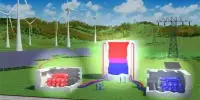Geothermal energy is thermal energy found in the Earth’s crust. It is a renewable and sustainable form of energy derived from the heat stored within the Earth’s crust. It combines energy from the formation of the planet and radioactive decay. This heat is produced by the formation of the Earth and the decay of radioactive isotopes. For millennia, geothermal energy has been used as a source of heat and/or electricity. It can be used for a variety of purposes, including electricity generation and direct heating applications.
Geothermal heating, for example, has been used for bathing since the Paleolithic period and for space heating since the Roman period. Since the twentieth century, geothermal power (the generation of electricity from geothermal energy) has been used. Geothermal plants, unlike wind and solar energy, produce power at a constant rate regardless of weather conditions. Theoretically, geothermal resources are more than enough to meet humanity’s energy needs. The majority of extraction occurs near tectonic plate boundaries.
During the 1980s and 1990s, the cost of producing geothermal energy fell by 25%. Technological advancements continued to lower costs and thus increase the amount of viable resources. The US Department of Energy estimates that power from a plant “built today” will cost around $0.05/kWh in 2021.
In 2019, there were 13,900 megawatts (MW) of geothermal power available globally. As of 2010, an additional 28 gigatonnes of heat were provided for district heating, space heating, spas, industrial processes, desalination, and agricultural applications. In 2019, the industry employed approximately 100,000 people. Customers may be willing to pay a little more for renewable energy, according to pilot programs such as EWEB’s customer opt-in Green Power Program.
Geothermal energy offers several advantages:
- Renewable: It derives its heat from the Earth’s internal heat sources, making it a renewable energy source as long as the heat extraction rate does not exceed the natural replenishment rate.
- Reliable and Baseload: Unlike solar or wind energy, geothermal energy is not intermittent and can provide a consistent and reliable source of power. This makes it suitable for baseload power generation.
- Low Emissions: It generation produces very low emissions compared to fossil fuel-based power sources, reducing greenhouse gas emissions and air pollution.
- Small Land Footprint: It plants typically require less land compared to solar or wind farms of similar capacity.
However, there are also challenges and limitations associated with geothermal energy:
- Location Dependency: Geothermal resources are not evenly distributed worldwide. They are most abundant in regions with high geological activity, such as the Pacific Ring of Fire. Areas without access to these resources cannot easily benefit from geothermal energy.
- Resource Depletion: If not managed properly, geothermal reservoirs can be depleted over time, leading to a reduction in heat output and the potential need for artificial reinjection.
- High Initial Costs: The development of geothermal power plants often requires significant upfront investment, particularly in drilling and exploration.
















